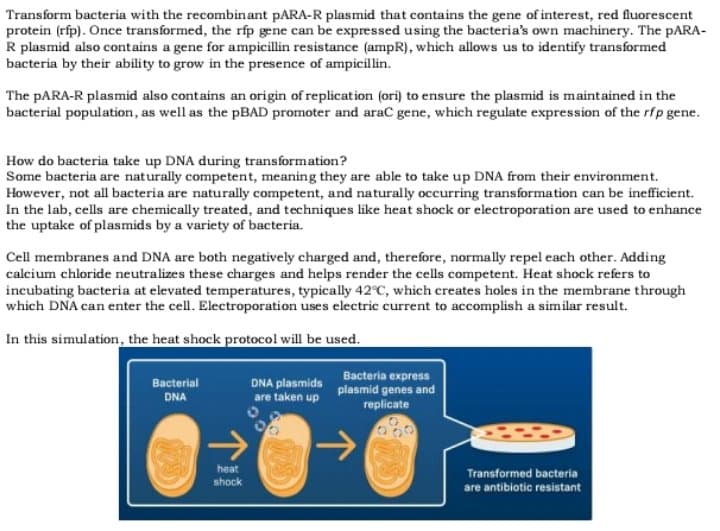What is the purpose of this experiment?
Biochemistry
9th Edition
ISBN:9781319114671
Author:Lubert Stryer, Jeremy M. Berg, John L. Tymoczko, Gregory J. Gatto Jr.
Publisher:Lubert Stryer, Jeremy M. Berg, John L. Tymoczko, Gregory J. Gatto Jr.
Chapter1: Biochemistry: An Evolving Science
Section: Chapter Questions
Problem 1P
Related questions
Question
What is the purpose of this experiment?

Transcribed Image Text:Transform bacteria with the recombinant PARA-R plasmid that contains the gene of interest, red fluorescent
protein (rfp). Once transformed, the rfp gene can be expressed using the bacteria's own machinery. The PARA-
R plasmid also contains a gene for ampicillin resistance (ampR), which allows us to identify transformed
bacteria by their ability to grow in the presence of ampicillin.
The PARA-R plasmid also contains an origin of replication (ori) to ensure the plasmid is maintained in the
bacterial population, as well as the PBAD promoter and araC gene, which regulate expression of the rfp gene.
How do bacteria take up DNA during transformation?
Some bacteria are naturally competent, meaning they are able to take up DNA from their environment.
However, not all bacteria are naturally competent, and naturally occurring transformation can be inefficient.
In the lab, cells are chemically treated, and techniques like heat shock or electroporation are used to enhance
the uptake of plasmids by a variety of bacteria.
Cell membranes and DNA are both negatively charged and, therefore, normally repel each other. Adding
calcium chloride neutralizes these charges and helps render the cells competent. Heat shock refers to
incubating bacteria at elevated temperatures, typically 42°C, which creates holes in the membrane through
which DNA can enter the cell. Electroporation uses electric current to accomplish a similar result.
In this simulation, the heat shock protocol will be used.
DNA plasmids
are taken up
Bacteria express
plasmid genes and
replicate
Bacterial
DNA
->
heat
Transformed bacteria
are antibiotic resistant
shock
Expert Solution
This question has been solved!
Explore an expertly crafted, step-by-step solution for a thorough understanding of key concepts.
This is a popular solution!
Trending now
This is a popular solution!
Step by step
Solved in 4 steps

Recommended textbooks for you

Biochemistry
Biochemistry
ISBN:
9781319114671
Author:
Lubert Stryer, Jeremy M. Berg, John L. Tymoczko, Gregory J. Gatto Jr.
Publisher:
W. H. Freeman

Lehninger Principles of Biochemistry
Biochemistry
ISBN:
9781464126116
Author:
David L. Nelson, Michael M. Cox
Publisher:
W. H. Freeman

Fundamentals of Biochemistry: Life at the Molecul…
Biochemistry
ISBN:
9781118918401
Author:
Donald Voet, Judith G. Voet, Charlotte W. Pratt
Publisher:
WILEY

Biochemistry
Biochemistry
ISBN:
9781319114671
Author:
Lubert Stryer, Jeremy M. Berg, John L. Tymoczko, Gregory J. Gatto Jr.
Publisher:
W. H. Freeman

Lehninger Principles of Biochemistry
Biochemistry
ISBN:
9781464126116
Author:
David L. Nelson, Michael M. Cox
Publisher:
W. H. Freeman

Fundamentals of Biochemistry: Life at the Molecul…
Biochemistry
ISBN:
9781118918401
Author:
Donald Voet, Judith G. Voet, Charlotte W. Pratt
Publisher:
WILEY

Biochemistry
Biochemistry
ISBN:
9781305961135
Author:
Mary K. Campbell, Shawn O. Farrell, Owen M. McDougal
Publisher:
Cengage Learning

Biochemistry
Biochemistry
ISBN:
9781305577206
Author:
Reginald H. Garrett, Charles M. Grisham
Publisher:
Cengage Learning

Fundamentals of General, Organic, and Biological …
Biochemistry
ISBN:
9780134015187
Author:
John E. McMurry, David S. Ballantine, Carl A. Hoeger, Virginia E. Peterson
Publisher:
PEARSON